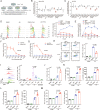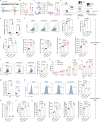BET bromodomain inhibition rescues PD-1-mediated T-cell exhaustion in acute myeloid leukemia
- PMID: 35918330
- PMCID: PMC9346138
- DOI: 10.1038/s41419-022-05123-x
BET bromodomain inhibition rescues PD-1-mediated T-cell exhaustion in acute myeloid leukemia
Erratum in
-
Correction to: BET bromodomain inhibition rescues PD-1-mediated T-cell exhaustion in acute myeloid leukemia.Cell Death Dis. 2022 Aug 29;13(8):743. doi: 10.1038/s41419-022-05204-x. Cell Death Dis. 2022. PMID: 36038554 Free PMC article. No abstract available.
Abstract
Sustained expression of programmed cell death receptor-1 (PD-1) is correlated with the exhaustion of T cells, and blockade of the PD-1 pathway is an effective immunotherapeutic strategy for treating various cancers. However, response rates are limited, and many patients do not achieve durable responses. Thus, it is important to seek additional strategies that can improve anticancer immunity. Here, we report that the bromodomain and extraterminal domain (BET) inhibitor JQ1 inhibits PD-1 expression in Jurkat T cells, primary T cells, and T-cell exhaustion models. Furthermore, JQ1 dramatically impaired the expression of PD-1 and T-cell immunoglobulin mucin-domain-containing-3 (Tim-3) and promoted the secretion of cytokines in T cells from patients with acute myeloid leukemia (AML). In line with that, BET inhibitor-treated CD19-CAR T and CD123-CAR T cells have enhanced anti-leukemia potency and resistant to exhaustion. Mechanistically, BRD4 binds to the NFAT2 and PDCD1 (encoding PD-1) promoters, and NFAT2 binds to the PDCD1 and HAVCR2 (encoding Tim-3) promoters. JQ1-treated T cells showed downregulated NFAT2, PD-1, and Tim-3 expression. In addition, BET inhibitor suppressed programmed death-ligand 1 (PD-L1) expression and cell growth in AML cell lines and in primary AML cells. We also demonstrated that JQ1 treatment led to inhibition of leukemia progression, reduced T-cell PD-1/Tim-3 expression, and prolonged survival in MLL-AF9 AML mouse model and Nalm6 (B-cell acute lymphoblastic leukemia cell)-bearing mouse leukemia model. Taken together, BET inhibition improved anti-leukemia immunity by regulating PD-1/PD-L1 expression, and also directly suppressed AML cells, which provides novel insights on the multiple effects of BET inhibition for cancer therapy.
© 2022. The Author(s).
Conflict of interest statement
The authors declare no competing interests.
Figures







Similar articles
-
Gene Signature-Based Prognostic Model for Acute Myeloid Leukemia: The Role of BATF, EGR1, PD-1, PD-L1, and TIM-3.Int J Med Sci. 2025 Mar 19;22(8):1875-1884. doi: 10.7150/ijms.108527. eCollection 2025. Int J Med Sci. 2025. PMID: 40225861 Free PMC article.
-
Higher PD-1/Tim-3 expression on IFN-γ+ T cells is associated with poor prognosis in patients with acute myeloid leukemia.Cancer Biol Ther. 2023 Dec 31;24(1):2278229. doi: 10.1080/15384047.2023.2278229. Epub 2023 Nov 14. Cancer Biol Ther. 2023. PMID: 37962843 Free PMC article.
-
Characteristics and clinical correlation of TIM-3 and PD-1/PD-L1 expressions in leukemic cells and tumor microenvironment in newly diagnosed acute myeloid leukemia.Leuk Lymphoma. 2022 Feb;63(2):450-456. doi: 10.1080/10428194.2021.1984454. Epub 2021 Sep 29. Leuk Lymphoma. 2022. PMID: 34585994
-
Programmed death-1 checkpoint blockade in acute myeloid leukemia.Expert Opin Biol Ther. 2015;15(8):1191-203. doi: 10.1517/14712598.2015.1051028. Epub 2015 Jun 3. Expert Opin Biol Ther. 2015. PMID: 26036819 Free PMC article. Review.
-
The Potential Advantage of Targeting Both PD-L1/PD-L2/PD-1 and IL-10-IL-10R Pathways in Acute Myeloid Leukemia.Pharmaceuticals (Basel). 2021 Oct 29;14(11):1105. doi: 10.3390/ph14111105. Pharmaceuticals (Basel). 2021. PMID: 34832887 Free PMC article. Review.
Cited by
-
CAR-T Cells Immunotherapies for the Treatment of Acute Myeloid Leukemia-Recent Advances.Cancers (Basel). 2023 May 27;15(11):2944. doi: 10.3390/cancers15112944. Cancers (Basel). 2023. PMID: 37296906 Free PMC article. Review.
-
Analysis of prognostic biomarker models of TXNIP/NLRP3/IL1B inflammasome pathway in patients with acute myeloid leukemia.Int J Med Sci. 2024 May 27;21(8):1438-1446. doi: 10.7150/ijms.96627. eCollection 2024. Int J Med Sci. 2024. PMID: 38903927 Free PMC article.
-
Death-ision: the link between cellular resilience and cancer resistance to treatments.Mol Cancer. 2025 May 15;24(1):144. doi: 10.1186/s12943-025-02339-1. Mol Cancer. 2025. PMID: 40375296 Free PMC article. Review.
-
Progress of research on PD-1/PD-L1 in leukemia.Front Immunol. 2023 Sep 26;14:1265299. doi: 10.3389/fimmu.2023.1265299. eCollection 2023. Front Immunol. 2023. PMID: 37822924 Free PMC article. Review.
-
Epigenetic targeting to enhance acute myeloid leukemia-directed immunotherapy.Front Immunol. 2023 Sep 22;14:1269012. doi: 10.3389/fimmu.2023.1269012. eCollection 2023. Front Immunol. 2023. PMID: 37809078 Free PMC article. Review.
References
-
- Wherry EJ. T cell exhaustion. Nat Immunol. 2011;12:492–9. - PubMed
Publication types
MeSH terms
Substances
LinkOut - more resources
Full Text Sources
Medical
Molecular Biology Databases
Research Materials
Miscellaneous

